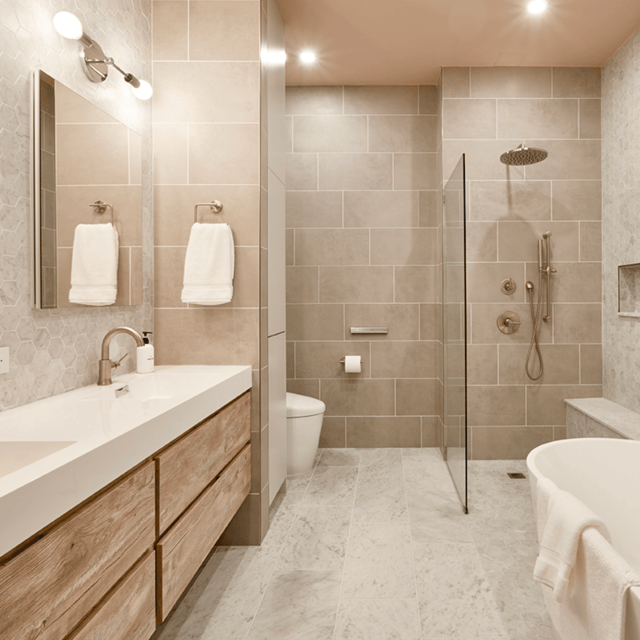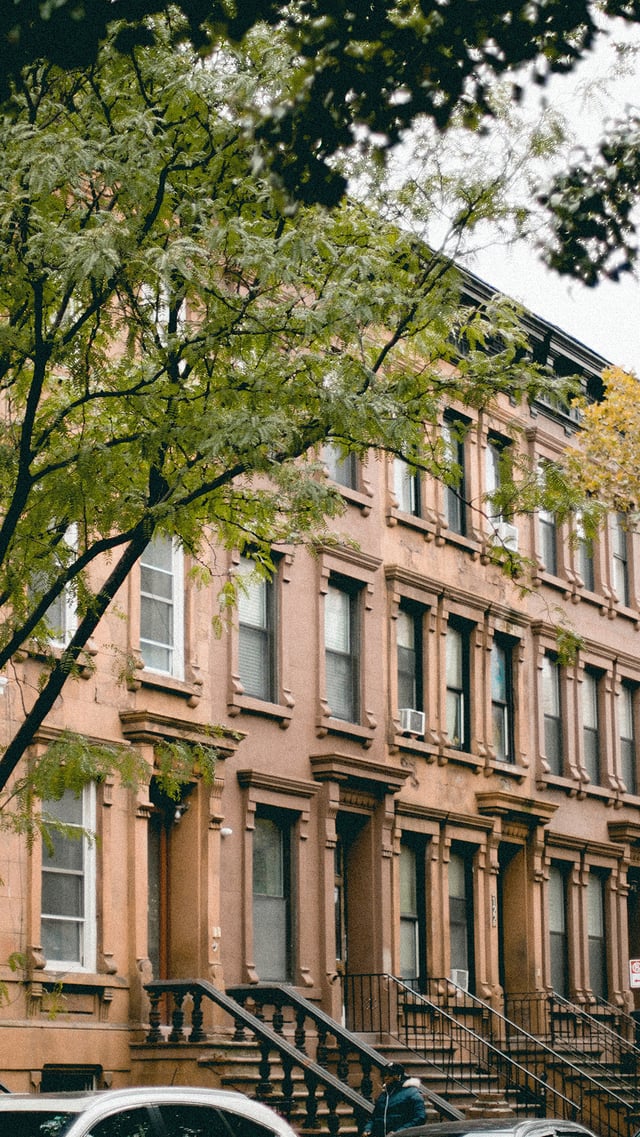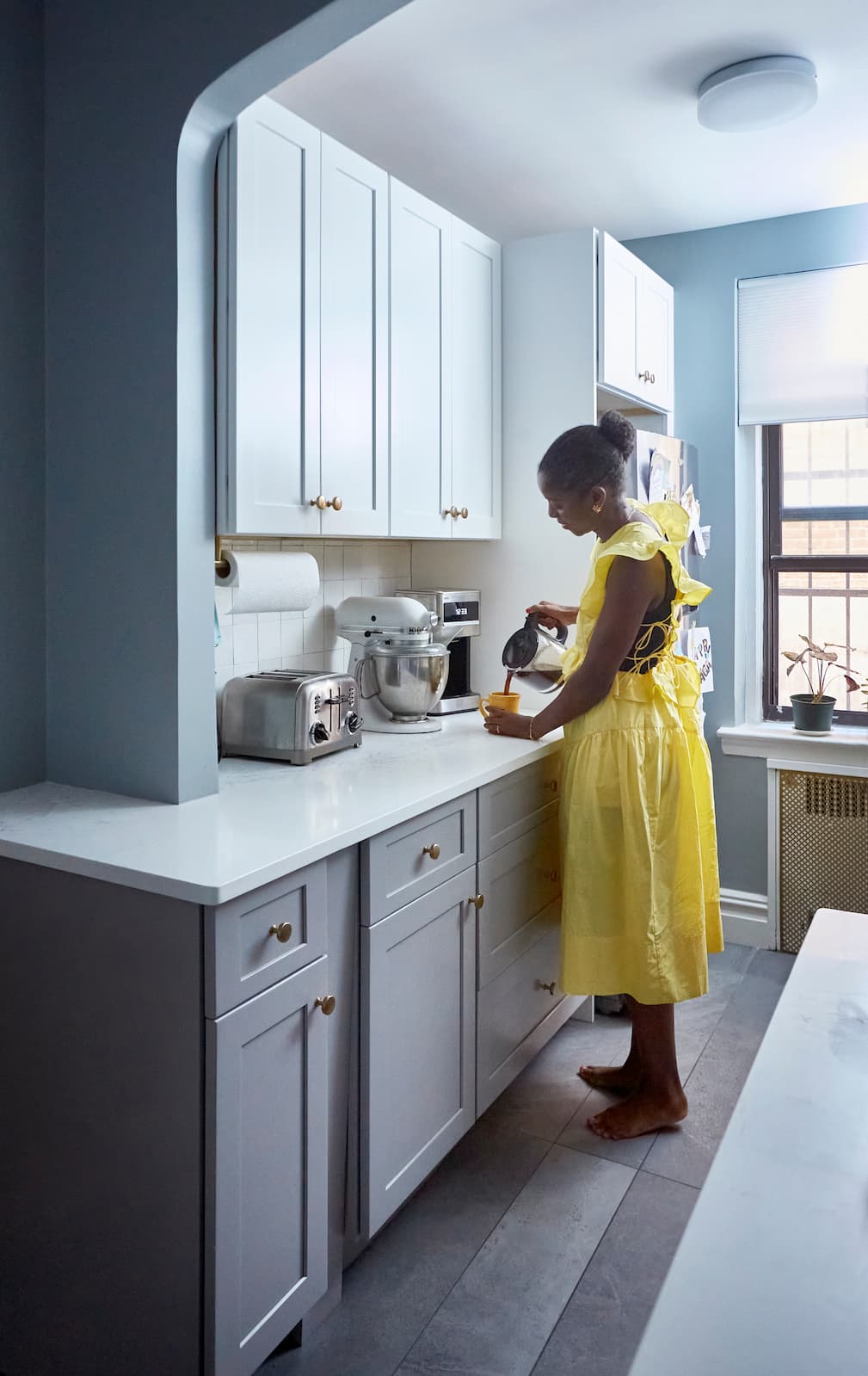
Bathroom
New York City Bathroom Remodels: Planning & Renovation Tips
12.05.2025
Our New Year savings event is here: Get up to $6,500 off your project today (terms apply).


In This Article
There's something magical about Brooklyn brownstones—their charming facades, historic significance, and undeniable place in New York City's architectural landscape. If you've managed to snag one of these gems or already called one home, congratulations! Now comes the exciting (and sometimes daunting) part: renovating. Whether you want to restore its original grandeur or modernize it to suit today's lifestyle, renovating a brownstone requires careful planning, patience, and, of course, a solid budget. Here's everything you need to know to make your brownstone renovation a dream instead of a nightmare.
You'll find rows of these classic homes across Brooklyn neighborhoods like Park Slope, Fort Greene, and Bed-Stuy, often boasting intricate stonework, high ceilings, and spacious layouts.
Before diving into the renovation process, it's essential to understand what makes a Brooklyn brownstone so unique. Owning a brownstone in Brooklyn is owning a piece of New York history.
These iconic buildings first made an appearance between the 1840s to the 1890s, and apart from their famous facade, their other noted exterior feature is the front stoop that gives the Brownstone an impressive appearance. An average brownstone has six floors, with each floor having a specific function. They tend to have a narrow width but extend in length with an average of 20 feet across and 40 to 45 feet deep.
Beyond the façade, brownstones are known for their original architectural details inside. From ornate moldings and woodwork to grand staircases and marble fireplaces, they embody Old New York charm. Of course, with history comes age, and that's where renovations come into play.
Get matched with local Brooklyn contractors

Mark
MRCR DBA Quality Contracting 4.5

Ion
Art Deco Enterprises 4.6

Alberto
XP Contractors Inc 5.0

Isli
SABI Construction USA Inc 5.0

Sanuar
A Better Plus Construction Inc 4.6

Sara and Ernesto
American Precision Developers LLC 4.8

Mladen
Petarson Renovations 5.0

Elias
Big Foot Contracting 4.5

Steven
Terranova Construction 5.0

Gad
Golden State Designs 4.9

Leonardo
Andes Project Contractor Corporation 4.5

Juan
Fancy Construction 4.9

Joseph and Anca
QB Construction Inc 5.0

Piotr
Peter Renovations Inc 4.8

Harold
AAA Construction Services, LLC 5.0
You might wonder: Why renovate a brownstone? The answer is simple: to preserve a piece of history, increase your property's value, and make your home more functional for modern living.
Brooklyn brownstones are part of the city's architectural DNA. When you renovate one, you're not just upgrading a home—you're contributing to the preservation of a neighborhood's character. Restoring original details like crown molding, parquet flooring, and fireplaces can maintain the historic value while giving your home a fresh, updated feel.
A well-renovated brownstone can add significant value to your property. In Brooklyn's competitive real estate market, homes that marry historic charm with modern amenities often command higher prices. Whether you're planning to sell in the future or just want to build equity, a thoughtful renovation is an investment that can pay off big time.
Let's be real—many brownstones were built before modern plumbing, electrical, and heating systems existed. If your brownstone hasn't been updated in a while, chances are it could benefit from some modernization. Updating the layout, adding energy-efficient windows, and installing modern appliances can vastly improve your quality of life.

Learn More: An Ultimate Guide to Gut Renovations in NYC
Renovating a Brooklyn brownstone isn't for the faint of heart—or the faint of wallet. The costs can vary widely depending on the scope of your renovation, and it's essential to plan for both expected and unexpected expenses. From structural repairs to aesthetic upgrades, renovating a brownstone requires a significant financial investment. Here's a rough estimate to help you budget accordingly. On average, a basic renovation might start around $100–$300 per square foot, including updates like painting, flooring, and minor cosmetic changes. For more extensive renovations, including structural changes, wet zones, or high-end finishes, costs can climb to $400–$800 per square foot or more. However, that number can increase depending on the level of luxury finishes, the complexity of the work, or any unforeseen issues that arise during construction.
Given that many Brooklyn brownstones are over a century old, it's not uncommon to encounter structural issues. These homes have withstood the test of time, but factors like settling foundations, cracked walls, and roof deterioration are typical challenges. Structural repairs, while a significant cost, are not just about preserving the home's appearance but also ensuring its long-term stability. This emphasis on safety and comfort should reassure you that your investment is in the right place.
If your brownstone still has its original plumbing, heating, or electrical systems, you're likely dealing with outdated and inefficient infrastructure. Upgrading these mechanical systems, while not the most glamorous part of a renovation, is a crucial step. This can include installing modern HVAC systems, replacing old pipes, or rewiring the entire home to meet current standards. The cost of plumbing and electrical work alone can be significant, but these updates are essential for creating a comfortable, energy-efficient living space that will last for years to come.
Once the mechanical systems are updated, the next step is making the space look great. Cosmetic renovations typically include carpentry, refinishing floors, and upgrading kitchens and bathrooms. Carpentry alone can cost $125,000 or more, while redoing the kitchen will cost upwards of $25,000. Bathrooms are another significant expense, costing upwards of $30,000. Don't forget demolition and removal costs, which will add around $10,000 to your budget. Miscellaneous costs like painting, trim, and finishing touches can add an additional $30,000 to $40,000. These upgrades are where you can really get creative and bring your personal style to life.
There are other considerations to factor into your renovation budget. For example, adding a rooftop deck can cost $25,000 or more, while replacing the roof could set you back $15,000 or more. If your brownstone's windows need replacing, that will cost $20,000.
Finally, don't overlook permits. Navigating Brooklyn's historic preservation rules is essential, especially if your home is located in a landmark district. Getting the necessary permits can add to your overall renovation costs, but this is a crucial step to ensure your project complies with local regulations and avoids potential issues in the future.
Learn More: The Ultimate Guide to Home Renovation Costs in New York City

So you've decided to renovate your brownstone. Great! Now comes the planning stage, which is arguably the most crucial part of the process. Here's how to make sure your renovation goes as smoothly as possible:
Because brownstones are often located in historic districts, it's important to familiarize yourself with the local building codes and regulations. In many cases, you'll need approval from the Landmarks Preservation Commission (LPC) before making any changes to the exterior of your home. Even minor updates like replacing windows or painting the facade can require a permit, so make sure you do your homework.
Brownstone renovations can take anywhere from 6 to 12 months, but this can stretch longer if you encounter any surprises along the way (and trust me, you will). If your project requires structural repairs or extensive work on the foundation, you may be looking at a timeline closer to 18 months. It's important to work closely with your contractor to set a realistic timeline and build in some buffer time for delays.
Old homes, like brownstones, often have hidden problems lurking behind walls and under floors. Water damage, rotting wood, and outdated wiring are all common issues that can drive up your renovation costs. To avoid financial stress, it's a good idea to set aside an additional 10-15% of your total budget for unexpected expenses.
If you're ready to dive deeper into the planning phase, check out this guide to planning a home renovation, which covers everything from creating a timeline to selecting a contractor.
Looking for inspiration? Here are some renovation ideas to help you bring your brownstone into the 21st century while maintaining its historic charm.
Many brownstones were built with small, closed-off rooms, which can feel cramped by today's standards. Consider knocking down walls to create an open-concept layout. This can make your space feel larger and more modern while still keeping the character of your brownstone intact.
One of the best parts of owning a brownstone is the potential to restore its original features. From crown molding and ceiling medallions to marble fireplaces and parquet floors, these details can add character and charm to your home. If the original features are in poor condition, consider hiring a specialist to restore them rather than replacing them with modern alternatives.

If you're lucky enough to have a brownstone with a flat roof, consider transforming it into a rooftop deck or garden. With space at a premium in Brooklyn, a rooftop deck can be a game-changer, offering a private outdoor space for entertaining or simply relaxing. Imagine enjoying summer nights with a view of the city skyline!

Let's face it: Kitchens and bathrooms are often the first places in a home to show their age. Upgrading these spaces can make your brownstone more functional and increase its value. Consider modern appliances, energy-efficient fixtures, and sleek cabinetry to bring these rooms into the 21st century.

Green renovations are all the rage and for a good reason. Consider incorporating sustainable features like energy-efficient windows, solar panels, and eco-friendly materials. Not only will this reduce your carbon footprint, but it can also save you money on utilities in the long run.
Renovating a brownstone can be an incredibly rewarding experience, but it's easy to make mistakes along the way. Here are some of the most common pitfalls to avoid:
It's easy to get carried away with dreams of marble countertops and high-end finishes, but it's important to be realistic about your budget. Brownstone renovations are often more expensive than anticipated, especially when you factor in structural repairs and unexpected issues. Make sure to create a detailed budget and stick to it as closely as possible.
This is a big one. Failing to obtain the necessary permits can result in costly fines and even stop your renovation in its tracks. Make sure to work with a contractor who is familiar with Brooklyn's building codes and has experience navigating the permit process.
While it's tempting to strip your brownstone of all its old-world charm in favor of sleek, modern design, resist the urge to go too far. The key to a successful brownstone renovation is finding a balance between old and new. Preserve original details wherever possible, and choose modern updates that complement the home's historic character.

Written by Block Renovation
Do I need permits for a Brooklyn brownstone renovation?
How do I choose a contractor for a brownstone renovation?
How can I maintain my brownstone after renovation?
How long does a typical Brooklyn brownstone renovation take?
What is the difference between a brownstone and townhouse?
A townhouse is a multi-story home that shares walls with neighboring houses and refers to the building’s style and structure, regardless of the exterior material. A brownstone, on the other hand, is a specific type of townhouse with a facade made from brownstone, a reddish-brown sandstone popular in the 19th century. So, while all brownstones are townhouses, not all townhouses are brownstones—the key difference is the signature stone exterior. Brooklyn townhouse owners interested in renovating may find value in our guide Townhouse Renovation Ideas & Key Considerations.

Renovate confidently with Block
Easily compare quotes from top quality contractors, and get peace of mind with warranty & price protections.
Thousands of homeowners have renovated with Block

4.5 Stars (100+)

4.7 Stars (100+)

4.5 Stars (75+)

Bathroom
New York City Bathroom Remodels: Planning & Renovation Tips
12.05.2025

New York
Best Brooklyn Contractors: Guide to Trusted Renovation Specialists
11.27.2025

New York
NYC Office Renovations: Contractors & Remodeling Tips
11.14.2025

New York
Bronx Renovations: Contractors, Cost & Inspiration
11.11.2025

New York
Williamsburg Kitchen & Bath Remodeling: Contractors, Cost & Tips
11.11.2025
Renovate confidently